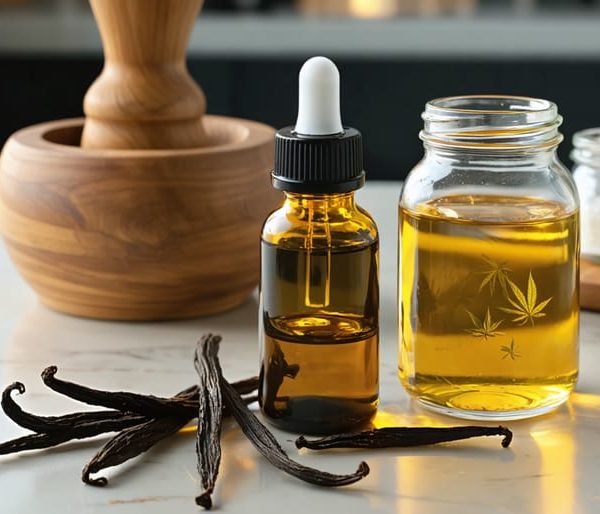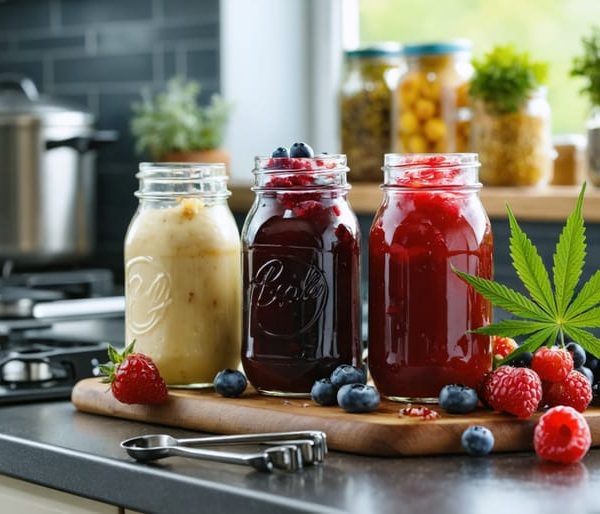Cannabis edibles occupy a unique classification that sets them apart from traditional concentrates, despite sharing some similar properties. While both products undergo extraction processes, edibles are technically infused food products rather than pure concentrated forms of cannabis. This distinction matters significantly for storage, handling, and legal compliance across Canada.
The confusion often stems from the fact that edibles are typically made using cannabis concentrates as ingredients – such as oils, distillates, or butter infused with cannabinoids. However, once these concentrates are incorporated into food products, they transform into a distinct category with their own specific regulations and storage requirements.
Understanding this classification is crucial for both consumers and retailers, as it directly impacts how these products should be handled, stored, and transported. Whether you’re a first-time user or an experienced consumer, recognizing that edibles require different care than concentrates ensures optimal preservation and compliance with Canadian cannabis regulations.
Understanding Cannabis Edibles Classification

Legal Definition of Cannabis Concentrates
Under Canadian law, cannabis concentrates are specifically defined as products created through methods that concentrate the THC, CBD, and other cannabinoids from the cannabis plant. According to the Cannabis Act and its regulations, concentrates include both extracted and synthesized substances that exceed the potency of natural cannabis flower.
While edibles contain cannabis extracts, they’re classified separately from concentrates in Canadian legislation. The key distinction lies in the final form and intended use of the product. Concentrates are substances like hash, shatter, wax, or oils that are primarily intended for smoking, vaping, or dabbing. Edibles, though they may be made using concentrates, fall under their own distinct category with specific regulations regarding THC limits, packaging, and labeling.
The Cannabis Regulations set a clear THC limit of 10mg per package for edibles, while concentrates can contain up to 1000mg of THC per package. This significant difference in allowable potency reflects how Canadian law views these products as fundamentally different categories, despite their related origins.
Where Edibles Fit In
While edibles are made using cannabis concentrates, they’re actually classified differently under Canadian cannabis regulations. Think of it this way: concentrates are the raw extracted cannabis compounds, while edibles are food products infused with these concentrates. It’s similar to how vanilla extract is a concentrate, but a vanilla cake is considered a baked good, not a concentrate.
Under Canada’s Cannabis Act, edibles fall into their own distinct category with specific regulations around THC content, packaging, and storage requirements. They’re subject to food safety standards that don’t apply to concentrates, including rules about shelf stability and potential allergens.
This distinction is important because it affects how you should store and handle your edibles. While concentrates typically need protection from light and heat, edibles have additional considerations like preventing food spoilage and maintaining proper texture. That’s why you’ll often find storage instructions on edible packaging that differ from concentrate guidelines.
Remember, this classification helps ensure proper handling and safety standards for each type of cannabis product.
Storage Requirements: Edibles vs. Concentrates
Temperature and Environment Control
Proper storage conditions play a crucial role in maintaining the quality and shelf life of cannabis edibles. The ideal temperature range for storing edibles is between 15-21°C (59-70°F), similar to how you’d store regular food items. Avoid exposing your edibles to temperatures above 25°C, as this can lead to melting, especially in chocolate or gummy products, and may affect the potency of the active ingredients.
Humidity is another important factor to consider. Keep your edibles in an environment with relative humidity between 55-65% to prevent moisture-related issues like mold growth or texture changes. If you’re storing edibles long-term, consider using airtight containers with humidity control packs.
Light exposure can degrade both the quality of your edibles and their cannabinoid content. Store them in a dark place, away from direct sunlight or bright artificial lighting. A kitchen cabinet or drawer works well, provided it’s not near heat-generating appliances or frequently exposed to temperature fluctuations.
In my experience helping customers at dispensaries, those who follow these storage guidelines typically report better preservation of both taste and effects. For optimal results, maintain consistent environmental conditions and always check your products for any signs of deterioration before consumption.
Remember, proper storage not only extends the life of your edibles but also ensures you’re getting the intended effects when you consume them. Keep them out of reach of children and pets, preferably in their original child-resistant packaging.
Packaging Considerations
Proper packaging plays a crucial role in maintaining the quality and potency of cannabis edibles. While some might consider freezing cannabis products as a storage solution, the immediate packaging environment is equally important. Always keep edibles in their original, child-resistant packaging that complies with Canadian regulations, as this helps preserve freshness and prevents accidental consumption.
For optimal preservation, look for containers that are:
– Airtight to prevent moisture and oxygen exposure
– Light-resistant to protect against UV degradation
– Food-grade quality to ensure no chemical leaching
– Temperature-stable to maintain product integrity
If you need to transfer edibles to a different container, choose dark glass jars or food-safe silicone containers with secure seals. Avoid using plastic containers, as they can affect taste and potentially interact with the cannabis compounds over time.
Remember to store individual pieces separately to prevent them from sticking together, especially in warm conditions. Using parchment paper between layers can help maintain product shape and prevent moisture accumulation. For gummies and chocolates specifically, consider using silica gel packets (from the original packaging) to control humidity levels when resealing.
By following these packaging guidelines, you’ll help ensure your edibles maintain their intended potency and quality throughout their shelf life while staying compliant with Canadian storage regulations.


Preservation Tips for Cannabis Edibles
Common Storage Mistakes
Proper storage of edibles is crucial, and I’ve noticed many consumers making common mistakes that can affect both quality and safety. One frequent error is leaving edibles in direct sunlight or near heat sources, which can cause them to melt or degrade more quickly. Even if they’re in their original packaging, heat exposure can significantly reduce potency and alter texture.
Another mistake is storing edibles alongside regular food without proper labeling. This creates a serious risk of accidental consumption, especially if there are children or unsuspecting adults in the household. Always keep your edibles in their original, clearly marked containers and store them separately from regular snacks and treats.
Some people also forget that edibles can absorb odours and flavours from their environment. Storing them next to strong-smelling foods or in a humid environment can affect their taste and quality. Similarly, keeping them in the refrigerator without proper sealing can lead to moisture absorption and potential mold growth.
Lastly, a common oversight is not checking expiration dates regularly. Even though cannabis products generally have a long shelf life, edibles contain other ingredients that can spoil. Always rotate your stock and dispose of any expired products properly.
Best Practices for Long-Term Storage
To maximize the longevity of your cannabis edibles, proper storage is essential. Keep your products in an airtight container made of glass or food-grade plastic to prevent moisture and air exposure. Store them in a cool, dark place with a consistent temperature between 15-20°C (59-68°F). Your kitchen cupboard or pantry typically works well, but avoid placing them near heat sources like ovens or sunny windowsills.
For chocolate-based edibles, refrigeration can help maintain quality, especially during warmer months. However, always check the product’s specific storage instructions, as some items may not require refrigeration. If you do refrigerate, use an airtight container to prevent condensation and protect against absorbing other food odours.
Label your storage containers with the purchase date and expected expiry date. Most edibles maintain their potency for 3-6 months when stored properly, though this can vary by product type. Watch for signs of degradation like changes in colour, texture, or smell.
Remember to keep all cannabis products, including edibles, in child-resistant containers and stored well out of reach of children and pets. Following these storage guidelines helps maintain both the quality and safety of your edibles while ensuring compliance with Canadian cannabis regulations.
My Personal Experience with Edible Storage
As someone who regularly enjoys cannabis edibles and has experience making cannabis edibles at home, I’ve learned quite a bit about proper storage through trial and error. Early in my journey, I made the mistake of keeping some gummies in a clear jar on my kitchen counter. Within a week, they had started to melt together and lose their potency – a costly lesson in the importance of proper storage.
Now, I always store my edibles in an airtight, opaque container in my refrigerator. For chocolate-based treats, I’ve found that keeping them in a sealed container in a cool, dark cupboard works just as well. I make sure to label everything with the date of purchase or creation, potency, and strain type – this has been incredibly helpful in tracking freshness and maintaining consistent dosing.
One particularly valuable lesson came when I discovered that storing different types of edibles together can affect their individual flavours and textures. I now use separate containers for different products, which has significantly improved their longevity and maintained their original quality. Temperature consistency is crucial too – I learned this the hard way after storing some edibles in my basement, where temperature fluctuations led to some unwanted texture changes.
In Canada, edibles occupy a unique position in cannabis classification, sharing some characteristics with concentrates while maintaining their own distinct category. While they do contain concentrated forms of cannabinoids, they’re regulated and stored differently from traditional concentrates like oils or shatter. For optimal safety and effectiveness, store your edibles in airtight containers in a cool, dark place, keeping them away from direct sunlight and heat. Remember to always follow the storage instructions on the product packaging and maintain them at appropriate temperatures (typically below 20°C). When in doubt, treat your edibles with the same care you’d give to perishable food items, and always keep them in their original, clearly labeled containers to ensure compliance with Canadian regulations. Most importantly, store them securely away from children and pets, marking them clearly to prevent accidental consumption.




